|
|
|
Sort Order |
|
|
|
Items / Page
|
|
|
|
|
|
|
| Srl | Item |
| 1 |
ID:
100387
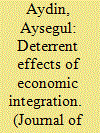

|
|
|
|
|
| Publication |
2010.
|
| Summary/Abstract |
Economic interdependence and international conflict studies have traditionally focused on the role of bilateral trade on direct deterrence, mostly omitting its indirect effects on third-party states. While scholars in the extended deterrence literature have examined the role of defender-target trade in deterring aggressors, most empirical research has remained limited to immediate deterrence and neglected general deterrence. This article synthesizes these literatures and goes beyond the dyad-level analysis in trade-conflict studies by focusing on the deterrent effects of trade. I claim that trade ties between the defender and target are not sufficient for extended general deterrence. This is mainly because international trade by itself is a poor indicator of the extent to which the target is an economically important friend of the defender, worth defending against aggressors. Empirical analysis of militarized disputes between rival states in the post-1945 period supports this point and shows that extended deterrence success is most likely in cases where the defender and target are economically integrated through regional trade institutions as well as conducting heavy trade. Economically minded defenders can successfully generate credible signals of resolve if they have institutional ties with their important trade partners.
|
|
|
|
|
|
|
|
|
|
|
|
|
|
|
|
| 2 |
ID:
100394
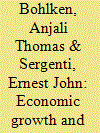

|
|
|
|
|
| Publication |
2010.
|
| Summary/Abstract |
Most studies of Hindu-Muslim riots in India have tended to emphasize the effects of social, cultural, or political factors on the occurrence of ethnic violence. In this article, the authors focus on the relationship between economic conditions and riots. Specifically, this article examines the effect of economic growth on the outbreak of Hindu-Muslim riots in 15 Indian states between 1982 and 1995. Controlling for other factors, the authors find that just a 1% increase in the growth rate decreases the expected number of riots by over 5%. While short-term changes in growth influence the occurrence of riots, this study finds no evidence of a relationship between the levels of wealth in a state and the incidence of ethnic riots. Moreover, by including state fixed effects, the authors determine that the negative relationship found between economic growth and riots is driven primarily by the relationship between growth and riots within a state over time rather than across states. These results are robust to controlling for a number of other factors such as economic inequality, demographic variables, political competition, temporal lags, spillover effects from adjacent states, and year effects. Finally, to address potential concerns that economic growth could be a consequence rather than a cause of violence or that other unobserved factors could confound the relationship between economic growth and the occurrence of Hindu-Muslim riots, the authors also employ instrumental variables (IV) estimation, using percentage change in rainfall as an instrument for growth. The results with IV estimation are similar to the results with non-IV estimation in terms of sign and significance, indicating that the negative effect of economic growth on riots is not due to reverse causality or omitted variables bias.
|
|
|
|
|
|
|
|
|
|
|
|
|
|
|
|
| 3 |
ID:
100390
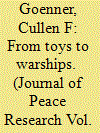

|
|
|
|
|
| Publication |
2010.
|
| Summary/Abstract |
The United States recently proposed to sell Saudi Arabia advanced weaponry worth 20 billion dollars over the next 10 years. The volume of trade, while significant, is second in the news headline that the United States would provide Saudi Arabia with precision-guided bombs, upgrades to its fighters, and new naval vessels. Trade of strategic commodities, such as armaments, suggests a strong interdependence between countries, which may influence international relations differently than the same volume of toys traded between nations. The author posits the volume and pattern of commodities that countries trade with each other are both relevant to interstate conflict. Commodities are heterogeneous and thus vary in terms of their strategic importance, substitutability, and ease of expropriation. This heterogeneity, along with the volume of trade, influences the opportunity cost of lost trade caused by conflict. This article empirically examines whether the pattern of trade is relevant to conflict for the period 1962-2000. The results from both single and simultaneous equations models indicate that increasing the share of bilateral trade in energy, non-ferrous metals, and electronics increases conflict, whereas for chemicals and arms it reduces conflict. Differences in these strategic commodities' elasticity of import demand and export supply, along with their ease of expropriation, contribute to the heterogeneous effects.
|
|
|
|
|
|
|
|
|
|
|
|
|
|
|
|
| 4 |
ID:
100398
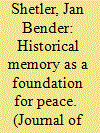

|
|
|
|
|
| Publication |
2010.
|
| Summary/Abstract |
While ethnic identity formulated by historical memory is often understood as the cause of violent conflict in Africa, this qualitative historical study of interethnic relations between Luo and Bantu-speaking communities on the borderlands of Tanzania and western Kenya demonstrates just the opposite. In fact, migration and violent conflicts over land in the late 19th century were the basis for oral traditions that established new microethnic identities. It was only in the colonial era that the modern macroethnicities of Luo and Suba (Bantu), as rigid oppositional identities, began to solidify around land disputes. Historical memory constructs these dynamic microethnic identities around interethnic reciprocal networks that were necessary for gaining security and access to land in the past. During these late 19th-century conflicts, interethnic alliances and marriages were the norm, resulting in many Bantu-speaking communities becoming Luo, to one degree or another. Historical memory, as the central tool for constructing ethnicity, can be used to promote either violence or peace, depending on how it is deployed. In western Kenya, an oppositional Luo identity resulted from the colonial construction of macroethnicity, while in North Mara, Tanzania, a different national narrative has resulted in relative peace. In his collection of oral traditions from North Mara, Zedekia Oloo Siso makes a case for these still salient microethnicities, based on regional networks that cross-cut ethnic boundaries, as the indigenous networks necessary for peace.
|
|
|
|
|
|
|
|
|
|
|
|
|
|
|
|
| 5 |
ID:
100393
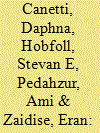

|
|
|
|
|
| Publication |
2010.
|
| Summary/Abstract |
The association between religion and violence has raised much interest in both academic and public circles. Yet on the individual level, existing empirical accounts are both sparse and conflicting. Based on previous research which found that religion plays a role in the support of political violence only through the mediation of objective and perceived deprivations, the authors test Conservation of Resource (COR) theory as an individual level explanation for the association of religion, socio-economic deprivations, and support for political violence. COR theory predicts that when individuals' personal, social or economic resources are threatened, a response mechanism may include violence. Utilizing two distinct datasets, and relying on structural equation models analysis, the latter two stages of a three-stage study are reported here. In a follow-up to their previous article, the authors refine the use of socio-economic variables in examining the effects of deprivation as mediating between religion and political violence. Then, they analyze an independent sample of 545 Muslims and Jews, collected during August and September 2004, to test a psychological-based explanation based on COR theory. This study replaces measures of deprivation used in the previous stages with measures of economic and psychological resource loss. Findings show that the relationship between religion and support of political violence only holds true when mediated by deprivations and psychological resource loss. They also suggest that the typical tendency to focus on economic resource loss is over-simplistic as psychological, not economic, resources seem to mediate between religion and support of violence.
|
|
|
|
|
|
|
|
|
|
|
|
|
|
|
|
| 6 |
ID:
100389
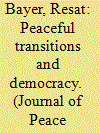

|
|
|
|
|
| Publication |
2010.
|
| Summary/Abstract |
While there has been extensive interest in the role of democracy in reducing interstate violence, the role of democracy in reaching higher levels of peace has received much less attention. Since many countries have less than amicable relations, it is necessary to consider how the quality of peace can be improved. The quality of peace becomes particularly relevant when assessing relations of countries with a bellicose past. In order to capture improvement in relations, this article relies upon a framework that captures the various levels of peace that countries experience. The study maintains that democracy contributes to former belligerents reaching the highest levels of peace but that it is not helpful at the lower levels especially if only one side is a democracy. The article tests arguments on a dataset that captures the transitions from one level of peace to another for all former belligerents since 1816 and relies upon event history analysis. The results for peace are not the opposite of what is found for war. The findings demonstrate that democracy plays a substantial role in peaceful transitions at all levels. However, while joint democracy is important for reaching the highest levels of peace, democracy can hamper the progress of relations at the lowest levels of peace.
|
|
|
|
|
|
|
|
|
|
|
|
|
|
|
|
| 7 |
ID:
100396
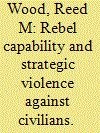

|
|
|
|
|
| Publication |
2010.
|
| Summary/Abstract |
This article explores the strategic motivations for insurgent violence against civilians. It argues that violence is a function of insurgent capacity and views violence and security as selective benefits that insurgents manipulate to encourage support. Weak insurgent groups facing collective action problems have an incentive to target civilians because they lack the capacity to provide sufficient benefits to entice loyalty. By contrast, stronger rebels can more easily offer a mix of selective incentives and selective repression to compel support. This relationship is conditioned by the counterinsurgency strategies employed by the government. Indiscriminate regime violence can effectively reduce the level of selective incentives necessary for insurgents to recruit support, thus reducing their reliance on violence as a mobilization tool. However, this relationship only holds when rebels are sufficiently capable of credibly providing security and other incentives to civilian supporters. These hypotheses are tested using data on one-sided violence from the Uppsala Conflict Data Program. The statistical analysis supports the hypothesis that comparatively capable insurgents kill fewer civilians than their weaker counterparts. The results also suggest a complex interaction between insurgent capability and government strategies in shaping insurgent violence. While weaker insurgents sharply escalate violence in the face of indiscriminate regime counterinsurgency tactics, stronger groups employ comparatively less violence against civilians as regime violence escalates.
|
|
|
|
|
|
|
|
|
|
|
|
|
|
|
|
| 8 |
ID:
100391


|
|
|
|
|
| Publication |
2010.
|
| Summary/Abstract |
When are economic sanctions expected to succeed? Previous studies predict that sanctions will be more effective when the issue at stake is important, when the sender and target are allied, when the target's domestic institutions are more democratic, and when the target's economy is dependent on the sender's. This article subjects these explanations to an empirical test using a new fully structural estimation that employs a game theoretic model as a statistical model. The initiation and outcomes of sanctions are incorporated with the strategic behaviors of sender and target states into a unified model. The model improves upon extant models by allowing the initial choice of the sender states to be multiple, not binary. This non-binary option enables the sender states to opt for the optimal intensity level of sanctions. Findings suggest that issue salience is positively associated with the decision to impose sanctions, but not necessarily with their effectiveness. Further, allied targets tend to comply even when they can win a sanctions contest, while non-allied targets tend to resist even when they know that on average the sender is likely to continue sanctioning in the face of resistance. Since sanctions imposed from 1903 to 2002 take place disproportionately between non-allied dyads, and thus belong to the category of sanctions most likely to fail, we can begin to understand why sanctions have such a low success rate.
|
|
|
|
|
|
|
|
|
|
|
|
|
|
|
|
| 9 |
ID:
100397


|
|
|
|
|
| Publication |
2010.
|
| Summary/Abstract |
Terrorism is designed to draw attention to particular issues and causes. Yet, the incidence of credit-taking (announcing one's responsibility for acts of terror) varies even though anonymity can undermine the clarity of the intended messages. This article offers an explanation of the variation in credit-taking that emphasizes how the competitive context in which groups operate shapes terrorists groups' need to cultivate support for their activities. Increasing numbers of terrorist organizations make it difficult for the supporters of terrorism to reward the perpetrators of particular attacks with their backing. Since such support is critical to the proper functioning of terrorist organizations, groups use claims of responsibility to distinguish themselves from those that had no hand in the violence. Consequently, variation in the probability of credit-taking fluctuates as a function of the number of active terrorist groups in a given theater of operations. This argument is contrasted with theories that suggest credit-taking is influenced by: the ideological mix of terrorist organizations; the willingness of governments to respond to terrorism using military force; state sponsorship; the depth of communal grievances; and the use of suicide attacks. The results, based on an analysis of transnational terrorism events conducted in the Israeli theater of operations between 1968 and 2004, suggest that competitive context is a consistently strong predictor of credit-taking. By implication, the results point to the utility of counter-terrorism strategies that interfere with the transmission of information between terrorist organizations and their supporters.
|
|
|
|
|
|
|
|
|
|
|
|
|
|
|
|
|
|
|
|
|